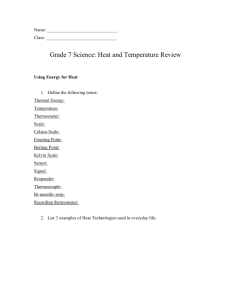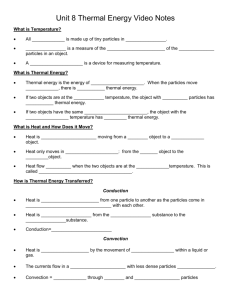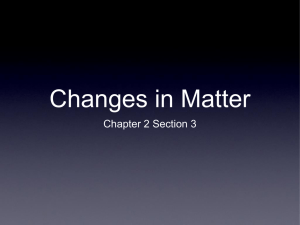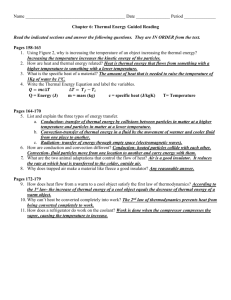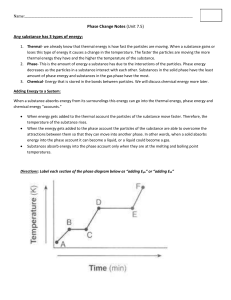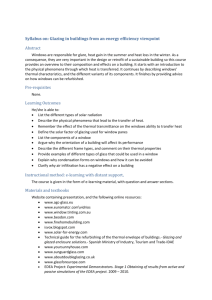Unit 3 – Heat and Temperature
advertisement
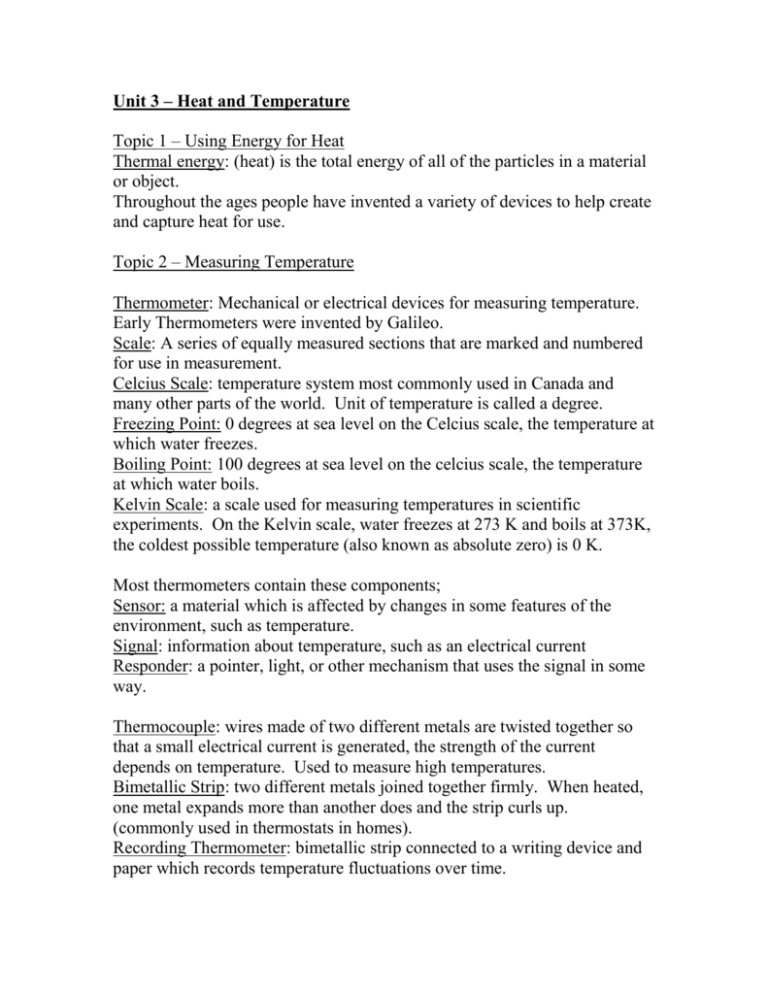
Unit 3 – Heat and Temperature Topic 1 – Using Energy for Heat Thermal energy: (heat) is the total energy of all of the particles in a material or object. Throughout the ages people have invented a variety of devices to help create and capture heat for use. Topic 2 – Measuring Temperature Thermometer: Mechanical or electrical devices for measuring temperature. Early Thermometers were invented by Galileo. Scale: A series of equally measured sections that are marked and numbered for use in measurement. Celcius Scale: temperature system most commonly used in Canada and many other parts of the world. Unit of temperature is called a degree. Freezing Point: 0 degrees at sea level on the Celcius scale, the temperature at which water freezes. Boiling Point: 100 degrees at sea level on the celcius scale, the temperature at which water boils. Kelvin Scale: a scale used for measuring temperatures in scientific experiments. On the Kelvin scale, water freezes at 273 K and boils at 373K, the coldest possible temperature (also known as absolute zero) is 0 K. Most thermometers contain these components; Sensor: a material which is affected by changes in some features of the environment, such as temperature. Signal: information about temperature, such as an electrical current Responder: a pointer, light, or other mechanism that uses the signal in some way. Thermocouple: wires made of two different metals are twisted together so that a small electrical current is generated, the strength of the current depends on temperature. Used to measure high temperatures. Bimetallic Strip: two different metals joined together firmly. When heated, one metal expands more than another does and the strip curls up. (commonly used in thermostats in homes). Recording Thermometer: bimetallic strip connected to a writing device and paper which records temperature fluctuations over time. Infrared Thermogram: records infrared radiation, (heat sensor) as different colors according to their temperature. Topic 3 – The Particle Model, Temperature, and Thermal Energy The Particle Model: - All substances are made of tiny particles too small to be seen - Particles are always in motion - Particles have spaces between them The motion of particles increases as temperature increases and decreases as temperature decreases. *Temperature indicates the average speed of particle motion in a substance. Energy: is a measure of something’s ability to do work. Two Principals apply whenever change occurs: - changes happen when there is a difference in energy - Energy is always transferred from a high-energy source to something with a low energy source. Law of Conservation of Energy (important) Energy cannot be created or destroyed, only transformed from one type to another or passed form one object to another. Topic 4 – Expansion and Contraction Contract: decrease in volume Expand: Increase in volume Temperature changes cause things to expand and contract Heated – usually causes expansion Cooled – usually causes contraction Usually more drastic changes in gases, then liquids, then solids. Topic 5 – The Particle Model and Changes of State Heat Capacity: amount of thermal energy that warms or cools the object by one degree Celcius Specific Heat Capacity: amount of thermal energy that warms or cools one gram of a material by one degree Celcius. *See Table 2 pg. 218 Changes of State Gas vaporization Sublimation condensation Melting (also called fusion) Solid Liquid Freezing (also called solidification) Melt: turn from a solid to a liquid Freeze: turn from a liquid to a solid Evaporate: turn from a liquid to a gas Condense: Turn from a gas to a liquid Sublimation: turn from a solid to a gas or a gas to a solid. Evaporative cooling: a process in which the faster-moving particles on the surface of a liquid evaporate and escape into the air, the slower ones are left behind creating a lower average kinetic energy (cooling it). Particles are less organized as the energy increases. This means the warmer the substance, the more disorganized the particles. Phase Changing During a change from solid to liquid or liquid to gas the average temperature does not change even though heat is being added, the name for the heat that is added is Latent heat Topic 6 – Transferring Energy There are three Main ways to transfer energy -Radiation -Conduction -Convection Energy Source: an object or material that can transfer its energy to other objects. Radiation: the transfer of energy without any movement of matter. Radiant energy: (also known as electromagnetic radiation or EMR for short) Energy that is transferred by radiation. All of the forms of Radiant energy share several characteristics: - They behave like waves - They can be absorbed and reflected by objects - They travel across empty space at the same very high speed 300000 km/s Conducting Energy Through Solids Thermal Conduction: the process of transferring thermal energy through direct collisions between particles. Heat Insulators: are very poor conductors Fluid: Materials that can be poured or that flow from place to place. Convection: A warm fluid, moves from place to place, carrying thermal energy with it. Convection Current: a moving fluid. * Know Energy Transfer Diagram (Figure 3.26 on pg. 232) Topic 7 – Sources of Thermal Energy Energy appears in many forms. Potential energy: Stored energy Two examples of this type are:- gravity (a rock sitting on a counter) - elastic (pulled back and ready to be shot). Kinetic energy: Energy of motion. (the energy present in a moving object) Chemical energy: is the kind used by our body (complex sugars are broken down to provide your muscles with energy). It can also be found in batteries (which also have potential energy). Different forms of energy can be converted into another form. e.g. a candle can convert chemical energy into heat and light (candles are energy converters) Energy Converters: Devices that convert or change energy from one form to another. Mechanical Forces- is a source of thermal energy caused by friction (car engine) Geothermal Energy: energy that can we harness from the Earth’s interior. Electrical Converters- Generate electrical Energy Dams: Gravitational potential energy of water held in reservoirs converted into electrical Coal: Chemical energy is turned into thermal, which converts into electrical Solar Energy – 2 types: Passive Solar: using materials and in the structure to absorb, store and release solar energy. Active Solar: Convert light energy absorbed by solar collectors into electrical (much like plants do) Wind Energy: the energy of moving air which can be harnessed through the use of windmills. Fossil Fuels: chemicals made from plants and animals that died and decomposed millions of years ago and have preserved deep underground. Problems with Fossil Fuels -Pollution -Non-renewable Global Warming: when fossil fuels are burned and released into the air, the CO2 concentrations increase, which trap heat. Thermal Pollution: accidentally warming up the environment. Cogeneration: using waste heat to heat needed areas, generate electricity and do other useful tasks. Topic 8 – Conserving Our Fossil Fuel Resources There are many things that we can do to conserve energy -Insulate homes and water lines -Reduce the amount of energy we use (take shorter showers etc.) -Install a programmable thermostat -Carpool -Many other things *See Figure 3.43 on page 252 to learn how a refrigerator works.
